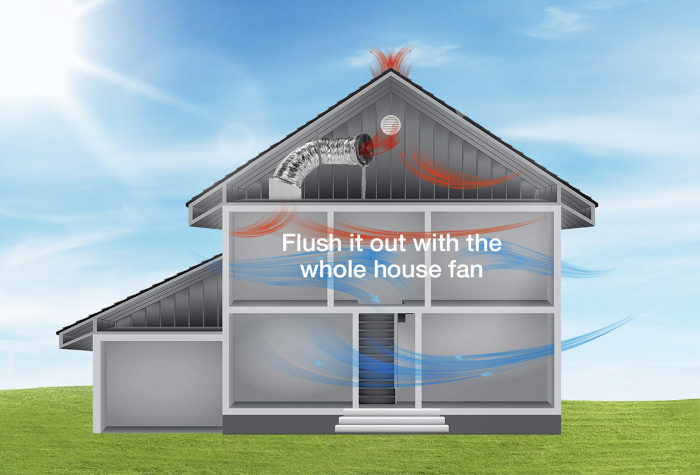Whole House Fans: A Cool Alternative (Sometimes)
If you’re looking for a cheaper way to cool your home during the summer without leaning so hard on your air conditioner, a whole house fan might be worth considering. These systems have been around for decades, and while they aren’t magic, under the right conditions they can be incredibly effective — and affordable.
Let’s walk through how they work, how much they cost to run, and where they shine (or fall short).
What Is a Whole House Fan?
A whole house fan is typically installed in the ceiling of a central hallway. It pulls cooler outdoor air in through your open windows and forces the hot air up into the attic and out the roof vents. The idea is to flush the house with fresh, cooler air, especially in the evenings or early mornings when outside temps are low.
The Math on Power Consumption
One of the biggest benefits of a whole house fan is how little power it uses compared to a central AC unit.
- Typical whole house fan: 200–700 watts
- Central AC (3-ton): Around 3,500 watts or more
Let’s assume:
- You run the fan 4 hours per night during the warm months (May through September – 5 months)
- You pay $0.14 per kWh for electricity
- Your fan draws 500 watts
Energy used per day:
0.5 kW × 4 hrs = 2 kWh/day
Monthly cost:
2 kWh/day × 30 days = 60 kWh
60 kWh × $0.14 = $8.40/month
Total for 5 months (May–September):
$8.40 × 5 = $42.00 for the entire season
Now compare that to central AC:
Let’s say your AC runs 6 hours/day during that same 5-month window:
3.5 kW × 6 hrs = 21 kWh/day
21 kWh × 30 days = 630 kWh/month
630 × $0.14 = $88.20/month
Total for 5 months:
$88.20 × 5 = $441.00 for the entire season
So you’re looking at a potential savings of around $399 over the summer if you’re able to replace your AC use with a whole house fan — or just reduce AC run time significantly.
Benefits of a Whole House Fan
✅ Low Operating Cost – As you saw above, it’s dirt cheap to run.
✅ Fast Cooling – If the outside air is cooler than your house, you’ll feel the difference within minutes. It’s great at clearing out hot, stale air.
✅ Lower A/C Dependence – Use it in the morning and evening to give your AC a break.
✅ Improves Air Quality – Constant air exchange flushes out odors, VOCs, and indoor pollutants.
✅ Extends Life of Your AC – Less run-time means less wear and tear.
What They Don’t Tell You (The Downsides)
❌ Only Works If It’s Cool Outside – If the outdoor air is 85°F and your house is 88°F, it’s not going to help much. It works best in dry climates or cool evenings.
❌ You’ll Have to Open Windows – Which may invite bugs, noise, and less security.
❌ Not Great During Wildfire Season or High Pollen – You’re pulling in outside air directly.
❌ Installation Isn’t Always Simple – You need attic space, proper venting, and a good seal so it doesn’t leak air when not in use.
❌ Can Suck Dangerous Fumes – If your garage or attic has fumes or a gas water heater nearby, you’ll need to be careful about backdrafting.
Typical Cost
- Fan system: $300–$1,200
- Installation: $500–$1,500 depending on your attic, wiring, and venting
Total installed cost usually falls between $1,000–$2,500. Some DIYers knock this down to under $1,000 with a weekend project.
Is a Whole House Fan Right for You?
If you live in a place where nights cool off (like much of Colorado or Northern California), and you’re comfortable cracking windows at night, a whole house fan can seriously reduce your A/C use and electric bill.
If you live somewhere hot and humid, or your house never really cools off at night, it probably won’t make much of a dent.
Final Thoughts
Whole house fans aren’t a replacement for AC — they’re a companion. A tool in your toolbelt. Used at the right time of day, they can be incredibly effective and cost next to nothing to run.
They’re not a fix for everyone, but they might be a smart move for you.

